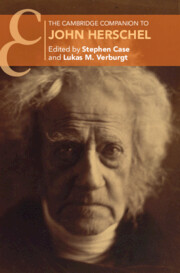Book contents
- The Cambridge Companion to John Herschel
- The Cambridge Companion to John Herschel
- Copyright page
- Contents
- Figures
- Contributors
- Acknowledgments
- Chronology
- Introduction
- 1 John Herschel
- 2 The Mathematical Journey of John Herschel
- 3 John Herschel’s Astronomy
- 4 Stargazer at World’s End
- 5 Herschel’s Philosophy of Science
- 6 Drawing Observations Together
- 7 Photology, Photography, and Actinochemistry
- 8 Herschel’s Planet
- 9 John Herschel and Scientific Standardization
- 10 John Herschel and Politics
- 11 John Herschel’s Methodology in the Scientific Community
- Further Reading
- Index
Introduction
Published online by Cambridge University Press: 08 May 2024
- The Cambridge Companion to John Herschel
- The Cambridge Companion to John Herschel
- Copyright page
- Contents
- Figures
- Contributors
- Acknowledgments
- Chronology
- Introduction
- 1 John Herschel
- 2 The Mathematical Journey of John Herschel
- 3 John Herschel’s Astronomy
- 4 Stargazer at World’s End
- 5 Herschel’s Philosophy of Science
- 6 Drawing Observations Together
- 7 Photology, Photography, and Actinochemistry
- 8 Herschel’s Planet
- 9 John Herschel and Scientific Standardization
- 10 John Herschel and Politics
- 11 John Herschel’s Methodology in the Scientific Community
- Further Reading
- Index
Summary
If anyone symbolized what it meant to “be scientific” and “do science” during the Victorian period, it was John Frederick William Herschel. Born on March 7, 1792, into astronomical royalty as the only son of William Herschel (1738–1822) and Mary Baldwin-Pitt (1750–1832), John was heir apparent to a scientific legacy that included the construction of immense telescopes and the discovery of hundreds of new celestial objects – including the solar system’s first new planet, Uranus. Yet John would prove to have an even longer, broader, and more influential career than his famous father. During a lifetime that spanned Britain’s entire age of reform, he achieved fame as a mathematician, chemist, optical experimentalist, astronomer, and public spokesperson of science. From his early contributions importing and developing advanced Continental mathematics into England, to laying the chemical foundations of photographic development with his discovery of hyposulfite “fixer,” to extending and establishing the pioneering work of his father and his aunt, Caroline Herschel (1750–1848), in sidereal astronomy, John Herschel came to embody the pursuit of natural knowledge in the nineteenth century.
- Type
- Chapter
- Information
- The Cambridge Companion to John Herschel , pp. 1 - 11Publisher: Cambridge University PressPrint publication year: 2024



